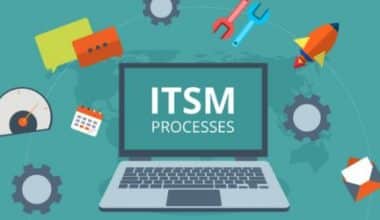Cutting-edge technology has always been the answer to enhanced productivity. Managing business assets, data, resources, clients, personnel, and so on is cumbersome, but there is software that makes this easy. With management software tools, it’s easier to keep tabs on every project and product through proper planning, tasks, and deadlines, making sure everyone meets them and keeping track of the time spent. Aside from projects and products, businesses also use management software to manage their assets, metadata, knowledge base, and configuration. In all, every piece of software makes work easier for managers and employees. It also leads to an improved productivity which is what every business would love to achieve.
What Is a Software Management Tool?
Software management tools are programming designed to carry out specific tasks, such as assisting individuals or groups to stay on top of their various projects and responsibilities.
Read Also: METADATA MANAGEMENT TOOLS: Meaning And All You Need To Know
Project Management Software Tools
Project management software tools are applications created specifically for managing projects. These applications help teams organize their work, monitor their progress, and meet their deadlines. As an added bonus, it encourages productive teamwork and speeds up projects so they can be completed within the required time frame. Additionally, we can also say that project management tools are software and online resources for managing projects that can be purchased or found for free. The following are some of the software tools available for your project management;
#1. Airtable
I so love the combination of two great features that Airtable integrated. These are spreadsheets and databases. So people who claim Excel is not a management tool can opt for Airtable. I also love the fact that it’s quite easy to use and can be changed to fit the needs of any business, no matter how big or small. Luckily, its spreadsheets allow users to organize data in many different ways, which is something that many people like. I personally think it makes up for the lack of robust reporting features with the different ways its data is seen. Airtable is one of the best project management software tools.
What Is The Cost Of Integrating The Airtable Tool Into An Organization?
Airtable’s monthly paid plans begin at $10 per user. They also have a free version that you can try out at any time. Their free plan includes essential features like collaboration, rich field types, and multiple views. While their paid plan has more advanced features, such as custom-branded forms, personalized views, and sharing that is only allowed within a certain domain.
#2. Wrike
You possibly can’t talk about software project management tools without mentioning Wrike. If you’re in search of cloud-based project management tools that will streamline your planning, track your team schedules, keep an eye on your deadline, or communicate with your stakeholders, you really should check out Wrike. It’s a robust suite for managing projects, and you can integrate it with a wide variety of other systems.
Wrike features include Gantt Charts, Task Management, a live newsfeed, and other sophisticated tools. It also allows managers to place their work on a preference scale, highlighting the most crucial issues that need urgent attention. Wrike can help you get the most important things done first and keep on track with your schedule. I particularly love the fact that Wrike can be used for a number of tasks. That is, different teams within an organization can adopt it for their project.
What Is The Cost Of Integrating Wrike Into An Organization?
The normal plan costs $9.80 per user, while the business plan costs $24.80 per user on a monthly basis. The cost of Wrike depends on the plan in question, but you can get a monthly plan for as low as $9.80 per user. However, the business plan comes at a monthly cost of $24.80 per user. However, they have a free version that you can check out, but the truth is, the free version has limited features.
#3. Monday.Com
People love the fact that Monday.com is quite adaptable and provides an open system for managing projects. That’s one of the reasons why it received a 4.2 rating, There’s no doubt it serves managers. One of the things that made Monday.com unique was that its interface and display can be changed to a variety of formats. It also includes multiple templates for you to choose from. Monday.com is easy-to-use project management software with a nice-looking interface and helpful tools for visualizing projects.
What Is The Cost Of Integrating the Monday.Com Tool In An organization?
The cost of Monday.Com depends on the plan in question but you can get 5 users monthly plan for $39. Unfortunately, it doesn’t have a free version for users
#4. Kanban Tool
Kanban as a software management tool is unique because Kanba users get to see how their work gets done and also keep track of time easily. Another unique feature of Kanban is that it’s easy to work together and keep track of tasks with its features. Some of these include notifications, reports, and team management. Small and medium businesses can use the mobile app while enterprises can host Kanban on their site.
What Is The Cost Of Integrating The Kanban Tool In An Organization?
The normal plan costs $5 per user, while the business plan costs $9 per user on a monthly basis. Kanban’s free version supports two users as well as two projects. Of course, you already know the free version does have limited features. So if you want to access their paid version, it begins at $5 per user for individual use. Then business users will pay $9 every month per user. As always, the paid plan gives you access to diverse features.
#5. Paymo
Paymo has advanced features for managing tasks, planning, scheduling, collaborating, billing, and keeping track of time. This is perfect for any size of business. If you decide to use Paymo, just know that you’re in for double value. Additionally, it lets you keep track of a project throughout its entire lifecycle.
What Is The Cost Of Integrating the Paymo Tool In An organization?
If you want to integrate Paymo into your business as a management tool, then you should consider getting the annual plan. This usually comes with a two-month bonus. I’m not sure if Paymo has a free version, but they do have two paid versions: the small office plan that costs $9.95 monthly per user and the business plan that cost $15.79 monthly per user.
#6. Clarizen
Clarizen is one of the platforms that allows users to track their resources. It also has robust reporting features. Even though Clarizen is perfect for managing projects, it can only be operated on the web, and this may limit its uses.
#7. ClickUp
Clickup is a service in the cloud that claims to be an all-in-one tool for managing projects. It stands out because it has a wide range of features, such as docs, goals, and an inbox. So it’s actually not a self-claimed feature but a reality. If you want absolute control and the ability to make changes at any time, then ClickUp could be your best bet.
What Is The Cost Of Integrating the ClickUp Tool In An organization?
The unlimited plan costs $5 per month for a single user, while the business plan costs $9 per month per user. ClickUp has a free version with 100 MB of storage. I think it’s one of the best free versions available. The free version allows unlimited tasks and members. It also has three plans, and each of these has distinct features that differ from the others.
#8. ProofHub
If you need software that’ll help you plan, keep track of your project, and organize your project, ProofHub may just be what you want. ProofHub is actually perfect for any small business or even a freelancer. It includes one of the most important management tools, Ghantt charts as well as workflow, calendar, discussion board, and o on. It’s indeed a central workplace for any project. Beyond teamwork, it provides businesses opportunities to relate with their client outside the business.
What Is The Cost Of Integrating the ProofHub Tool In An organization?
I really can’t tell if ProofHub has a free version but I do know they allow no large number of users at an extra cost of course. They also have two plans. These are the Essential plans and the Ultimate control plans. The fit cost $50 per month and the second cost $99 per month.
#9. Zenkit
Zenkit is designed for teams that prefer to do their work in an agile way. It’s a well-known project management tool that lets you keep track of your data as you do research, come up with ideas, and work together on them. With Zenkit, you’ll definitely get multiple views, and reports, in addition to ways to manage your resources.
What Is The Cost Of Integrating the Zenkit Tool In An organization?
Users who are in search of free tools can try Zenkit. In addition to their free plan, they also have 3 paid plans which offer distinct features. These are namely Plus, Business, and Enterprise
Asset Management Software Tools
Software tools for asset management are generally application programs that businesses use to get the most out of their assets and keep the cost of lost or underused assets to a minimum. Asset management tools are central systems that keep track of and record all tangible and intangible assets or services in real time. The following are some of the best asset management tools available;
#1. Pulse
First on our list of asset management software tools is Pulse. I think the best feature of Pulseway is its ability to give users a modern and smart experience no matter what device or platform they are using.
The Pulseway mobile app lets you troubleshoot cloud-based servers and other operating systems, and it also gives you remote desktop access to Windows machines. It also allows users to kill processes, restart, log out, suspend, and lock non-Windows assets. Users can use a simple and attractive interface to get to all of the system’s functions, and connecting to the machine takes almost no time at all.
#2. GoCodes
This is a web-based program that helps businesses of any size keep track of their physical assets and inventory. GoCodes has built a strong, mobile-ready system for tracking physical assets using secure QR stickers.
It’s also one of the cheapest asset management software tools you’ll find. Aside from the fact that it’s affordable, it’s also very easy to set up and use. It also tracks network and non-network assets, in addition to the above, you don’t have to worry when your asset is powered off. This is because you can still keep track of it with this asset software. One of the fascinating things about this is that you can track your asset from any device, once a barcode has to be assigned to the asset in question. Additionally, you can easily calculate the depreciation of your assets.
#3. Atera
Atera as a management software is actually a cloud-based remote IT management platform that gives MSPs, IT consultants, and IT departments a powerful and all-in-one solution. With a low flat rate, you’ll definitely get Atera because of its affordable and innovative per-tech pricing model. You’ll also be able to manage an unlimited number of devices and endpoints. The software has 30-day trails and users can choose between its monthly plan and its yearly plan.
#4. Asset Panda
One of the fascinating things about Asset Panda is that it combines asset management and inventory management. Asset Panda is perfect for anyone with multiple assets. It’s built to accommodate a large number of assets, and users too. So if you’re looking out for management tools for your asset, you can check out Asset Panda. To track your inventory or asset, Panda uses UPCs or serial numbers. It doesn’t have a free version but it does allow a trial period of 14 days.
Features of Asset Panda
- Mobile app with lots of features and barcode scanning.
- It has a dashboard that is easy to customize.
- A dashboard that is easy to customize, a mobile app for multiple users
- Functional barcode scanning.
- Accept images, voice recordings, or videos. Asset Panda can handle all of that.
- Mobile app multiple Users Allows for custom report
Configuration Management Software Tools
Configuration management (CM) tools make it easy to find changes in hardware, software, and devices in an IT environment, document them and keep track of them. The following are some of the best configuration management software tools available.
#1. Rudder
Rudder is top on our list of configuration management software tools. According to software testing help, Rudder is one of the most well-known and widely used open-source, web-driven, role-based solutions, configurations, and audit management tools for automating system configuration and compliance across large IT organizations.
Features of Rudder Configuration Management Software Tools
The following are the key features of Rudder configuration management software tools
- It hosts inventory.
- Rudder makes easy administration tasks like installing or configuring run by themselves.
- Rudder offers a very unique custom policy editor.
- The back of the rudder has GIT on it.
- Rudder lets you talk to Rudder Server using the FULL REST API.
- A Web Interface that can be used to manage the nodes and set up policies.
#2. TeamCIty
TeamCity is based on the Java programming language and was built by the Jet Brains Team. It is also one of the most widely used open-source configuration management software tools. Why is TeamCity on our list of configuration management software tools? Because it can handle up to 100 build configurations (jobs) and can run an unlimited number of times. It also runs about 3 agents and allows users to add more if they chose to. So it’s really a great tool
#3. AssetExplorer
When choosing asset management software tools, one criterion that must be checked is that they can be accessed from anywhere, so long as there’s an internet connection. With AssetExplorer, you need not worry about anything because it meets the above criteria.
Whatever you want to achieve with asset management tools, trust AssetExploere to help you achieve that goal. AssetExplorer addresses every facet of IT asset management, from multi-source discovery techniques to real-time hardware and software dashboard
Features Of AssestExplorer Asset Management Tools
The following are some of the features of AssetsExplorer configuration software management tools;
- Locating Assets from Multiple Sources
- Predictive checks of assets through scanning
- Administration of software licenses and usage tracking
- Manages software asset
- Manages assets lifecycle
- Taking stock of IT assets
- A Database for Managing Configurations (CMDB)
- Native Integration of Microsoft’s SSC
- Tracks digital and physical possessions.
Product Management Software Tools
When we talk about product management software tools, we refer to any time-saving organizational device that helps businesses create and enhance their products more rapidly and effectively. Product management software tools help product managers and their teams gather fresh ideas and develop concrete strategies for turning those ideas into a marketable end result.
The following are some of the product management software tools available for managers;
#1. Jira
Project management and development teams can all benefit from using JIRA. Irrespective of the product goal, trust Jira to help you track issues, distribute tasks, and monitor progress. Users can decide to work on the web or simply make do with Jira’s mobile app. Whichever one you decide to use, Trust Jira to take care of things.
#2. Niffy
If you’re a manager who wants to keep your teams, projects, and departments in sync, then, you should consider Niffy. Nifty consolidates communication, workflow, objectives, documents, and files so that you can devote your attention where it’s needed most. It’s one of the project management software tools that offer solutions, speeds up development times, and boost team output.
This will generally result in an automated system for making progress toward goals that are driven by milestones. Moreso, it keeps everyone on the same page. The Niffy software tool includes Kanban, a compatible calendar, and so on to make every project work out as planned.
#3. Hive
Hive is yet another product management tool that made it to our list of product management tools. In their own words, “We help teams move faster.” This proves that it is actually designed to help you achieve your product goals. It’s little wonder that it’s the first truly decentralized system for managing projects.
To prove that it’s really after the success of your product management, Hive integrates everything in your workflow, from email and resourcing to group chat and file sharing.
#4. Aha
When it comes to product management software tools, your list will not be complete without Aha! Aha is an internet product strategy and road-mapping tool that can help you figure out the four Ws of every product. While it’s true that Aha doesn’t keep track of real-time, it has other features that are quite mind-blowing.
Features of Aha Product Management Software Tools
The following are some of the key features of Aha product management software tools;
- Templates for creating a product road map are available.
- Websites dedicated to the collection and administration of ideas
- Optional collaborative sharing of a road map
- Supports integration with a wide variety of popular platforms.
Is Excel A Project Management Tool?
Yes, Excel may likely serve as a project management tool. But the truth is, it depends on the project in question. Project managers can use Excel spreadsheets to create their budget plans and also track their expenses. So we can consider Excel as one of the software management tools, even though it can be used for other things aside from budgeting. In fact, whether Excel is a management software largely depends on what you intend to use it to achieve.
What is this management tool?
The term “Management Tools” refers to all software programs and programming (together with all alterations, upgrades, replacements, improvements, documentation, documents, and media connected thereto) that the Supplier employs to provide and oversee the Services.
What is the use of management tools?
Corporate management tools are any methods, programs, checks, calculations, techniques, etc. that an organization uses to adapt to changing markets, maintain its position as a leader in such markets, and enhance business performance.
Is Excel and ERP system?
Due to its accessibility, simplicity of use, and reputation as a cost-effective method of organizing and planning corporate operations, Excel is used extensively by manufacturing organizations for a variety of functions, including scheduling, inventory management, and data analysis.
What is MS project tool?
Microsoft Project is a project management tool used for scheduling, planning projects, managing resources, and keeping track of time. It contains features for project management experts like Gantt charts, kanban boards, and project calendars.
Is Gmail a project management tool?
No, Google doesn’t have any native project management software or apps. To make project plans and Gantt chart timeframes, however, there is a substitute for it. It is known as Google Sheets. You only need to enter your data, click Share, and add your team; no coding knowledge is required.
Is CRM a project management tool?
Teams can grasp tasks and projects that are related to developing client relationships easily with the help of a project management system built on a CRM platform. The client may be nurtured and provided the service they deserve while workflows can be built. A CRM project management system makes it all feasible.
Is SQL a ERP?
As a platform for applications, SQL Server is quite useful. Enterprise Resource Planning, sometimes known as ERP, is one of the biggest applications.
Is SQL ERP system?
Double entry accounting is used in the ERP system SQL-Ledger. An SQL Database Server is used to store accounting data, and a typical web browser can be used to access it. The system uses the Perl programming language with a database interface module for processing and PostgreSQL as the preferred platform for data storage.
What are the 5 Management Tools?
- Work breakdown activities
- Project Baseline
- Gantt chart
- Comunication management plan
- Team building activities
Every management software tool must integrate all of the above for efficiency.
Conclusion
There are management software tools that make work easy in every facet, from a business asset to its product, project, and even configurations, there’s software for whatever you want to achieve with it.
Management Software Tools FAQs
What are project management systems?
A project management system refers to any means of managing the progress of a project. Generally, it can serve as a guide for setting appropriate goals, allocating roles, and developing policies.
Is Microsoft team a project management tool?
Sure, it is. However, the usefulness of Microsoft Teams as a management team depends on what you intend to achieve with it.
What does asset management software do?
Asset management software tools help businesses achieve the following;
- Eliminate obsolete assets
- Reduce maintenance costs
- Inform decisions on new IT purchases
- Optimize software license utilization
- Make the business more compliant and audit-ready
- Increase protection against security risks
- FREE OKR SOFTWARE: 47+ Best Free OKR Software in 2023 (+ Free Tips )
- Project Management Software: 31+ Top Best PM Software For Business
- TASK MANAGEMENT SOFTWARE: 25 Best Task Management Software Solution
- MONEY MANAGEMENT TOOLs: What It Is, How To Use It, And Free Online Tools






